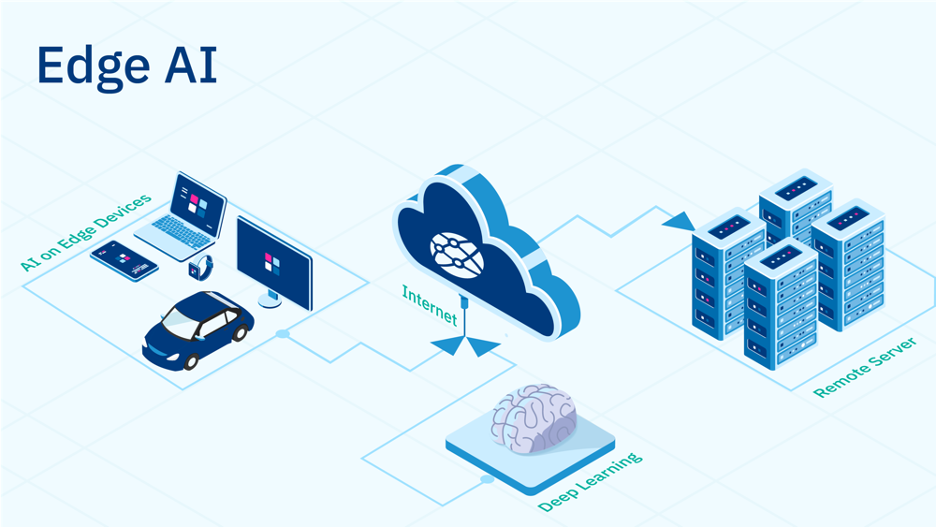An Introduction to Edge AI
By
Last Updated May 08, 2023
AI adoption has skyrocketed in recent years. With more corporate data, IoT applications, and customers utilising more devices than ever before, it's more important than ever for companies to bring AI intelligence closer to their customers. Edge AI enters the scene at this point.
As we progress through the post, we'll look at the various facets of Edge AI and the advantages the technology has to offer businesses. First, let's take a look at the Edge AI market.
Table of content
Let us see An Introduction to Edge AI:
1. What exactly is Edge AI?
2. The difference in cloud computing and AI architecture at the edge
3. What is the function of Edge AI?
4. What are some of the applications of Edge AI?
5. An Introduction to Edge AI
What exactly is Edge AI?
Artificial intelligence is primarily reliant on the calculation and transmission of complicated machine learning algorithms. Edge computing, on the other hand, sets a new computing method that brings AI closer to the point where data is generated and processed Edge computing AI is a new domain born from the marriage of AI with edge computing.
The technology allows speedier insights and computation, as well as increased security and operational control. As a result, it is possible to design high-performance AI programmes while keeping operating costs low.
The best part about this technology is that it enables the autonomous adoption of deep learning processes, machine learning, and advanced algorithms on IoT devices without relying on cloud services. Is there a distinction between cloud computing and Edge AI architecture, given the dependency on the cloud?
The difference in cloud computing and AI architecture at the edge
Cloud computing and edge AI are rarely interchangeable because each has its own set of applications and advantages. When handling time-sensitive data, performing procedures in faraway places that require local storage, and operating smart devices, edge AI architecture comes into play. High computing power, deep learning framework limits, and the inclusion of different inference devices are all limitations.
Cloud computing, on the other hand, allows for remote on-device processing with massive computing power over the internet. While the cloud provides additional design and architecture possibilities, it also reduces the amount of energy required for high-level computing.
What is the function of Edge AI?
A machine must be able to see, identify objects, interpret speech, and drive. What are the advantages of using Edge AI?
Edge computing AI offers a number of benefits. Whatever they are now, they are all focused on improving procedures and customer experience.
1. Data processing in real-time
One of the most significant advantages of Edge AI is that it brings high-performance computing power to the edge, where IoT devices and sensors are located.
AI edge computing technology allows AI use cases to be added directly to field equipment. The most prevalent Edge AI examples may be found in how software can handle data and machine learning in autonomous Edge AI applications, such as autonomous vehicles, using deep learning techniques. The technology can process data when used in an autonomous car.
2. Increased privacy
The data processing activities in Edge AI are carried out on a local basis on the edge computer. As a result, fewer data is transported to the cloud, lowering the danger of data being mishandled or misappropriated.
Data is now captured and processed closer to the devices, resulting in less transfer and improved data security.
3. Reduce internet bandwidth usage
Because Edge computing AI operates with data processing occurring locally, businesses save a significant amount of money on internet bandwidth because fewer data is transported over the internet.
If you utilise Amazon AWS AI Services for your organisation, you're well aware of how expensive AI operations can be.
4. Power usage is reduced.
Because data is processed locally with Edge AI solutions, businesses save a lot of energy because they don't have to stay connected to the cloud to send data back and forth between the Edge platform and the cloud. Furthermore, most edge computing devices have power consumption and efficiency characteristics.
The fact that the bulk of edge apps are deployed in remote areas necessitates that the edge computers balance performance and power.
5. Greater adaptability
When compared to cloud computing, where the device collects data, and sends it to the cloud, edge AI technology processes data locally, making it far more responsive.
All of this happens in a fraction of a second. As a result, Edge AI solutions take quicker actions and make quicker choices. This leads to programmes like intelligent automation, autonomous vehicles, and robotics that require immediate feedback.
What are some of the applications of Edge AI?
Manufacturing
Precision manufacturing facilities are required to ensure that there is no waste. When you incorporate Edge AI into the equation, you can ensure that the factory floor is both efficient and safe. You can check product quality with incredible precision by incorporating machine vision. It also aids in product automation and mechanical failure prediction.
The technology is used by Procter & Gamble in the form of inspection cameras. It analyses the videos acquired from the floor cameras to prevent defects from leaving the production.
Retail
Customer analytics are rarely overlooked by retail establishments. Customer analytics, on the other hand, is heavily reliant on everything digital - their views, where they left the website when they purchased what, and so on. This is good news for brick-and-mortar businesses.
Through video analytics, Edge AI is changing this. By bringing computing power closer to the stores, it can extract critical data from store videos about how happy visitors are, what they're looking for, and what they value - colour, price, size, touch, and so on.
Ingenious hospitals
The use of edge computing and artificial intelligence in medicine would enhance and encourage patient care while also improving operational efficiency.
Edge AI apps aid with data security, which is essential for hospitals to operate efficiently. Edge AI can be used in the medical industry to perform tasks such as –
- Thermal screening with high precision
- Management of inventory
- Patients are monitored remotely.
- Ailment forecasting
Drones
Edge AI applications in drones can be seen. Drones are used for visual search, image recognition, object detection, and tracking. When artificial intelligence (AI) is integrated to technology, it may make sense of the data collected by mimicking human search behaviour.
The use of Edge AI in drones would allow for more effective data analysis. It can also help with real-time tracking, predictive maintenance, object detection, and face recognition.
An Introduction to Edge AI
AI adoption has skyrocketed in recent years. With more corporate data, IoT applications, and customers utilising more devices than ever before, it's more important than ever for companies to bring AI intelligence closer to their customers. Edge AI enters the scene at this point.
As we progress through the post, we'll look at the various facets of Edge AI and the advantages the technology has to offer businesses. First, let's take a look at the Edge AI market.
What does Edge AI have in store for the future?
Edge AI is clearly growing in popularity. But this is just the beginning. In the domain, there have been several patterns that have emerged. Let us investigate them.
IT will be in charge of Edge AI management. Despite the fact that Edge AI is becoming more popular, its implementation remains difficult. The technology will be controlled in order to go to the production stage.
Edge AI and IoT convergence Manufacturing businesses, particularly those that have included IoT, emerge as the most prominent names in the area when it comes to AI adoption. We may expect to witness the convergence of IoT and Edge AI in use cases including sensors and cameras for inspection, preventative, and predictive maintenance in the next years.
Edge data centres are on the rise. More than five million servers will be installed at the edge by 2024. The number of data centres would only increase as a result of a variety of causes, including:
- Network 5G
- Proliferation of IoT
- SDN and NFV technology
- Video streaming combining augmented reality and virtual reality
The desire for lower latency, intermittent connectivity concerns, and other features will only increase. What are the drawbacks to using Edge AI?
Edge AI implementation has a lot of benefits, but it also has a lot of drawbacks. A number of factors contribute to the technology's difficulty in implementation.
1. A lack of hardware standards
Edge computing places a significant emphasis on hardware. What's more, the Edge AI hardware that is now available on the market lacks any standardised units. There are also a variety of factors to consider, such as use cases, power consumption, memory requirements, CPUs, and so on.
2. Combination of several factors
One component of the AI paradigm is hardware. It is not commonplace for developers to design apps using different models and frameworks. However, this integration, however, it can be difficult. Businesses may also use third-party platforms, which will require new interaction with the software and hardware used for Edge artificial intelligence.
3. Insufficient knowledge
Edge AI applications, like any industry in which it is being utilised, are continually developing. To meet this demand, you'll need experience in a variety of areas, including hardware selection, tool integration, deployment and testing model optimization, and so on. Finding a team of people who are knowledgeable with not only Edge AI but also the evolving tech stack can be difficult.
To overcome these obstacles, you'll need a trained team with experience working with Edge devices and a variety of Edge artificial intelligence use cases.
Recent Posts
Get a Free Quote.
Lets Build Your App!
Connect




